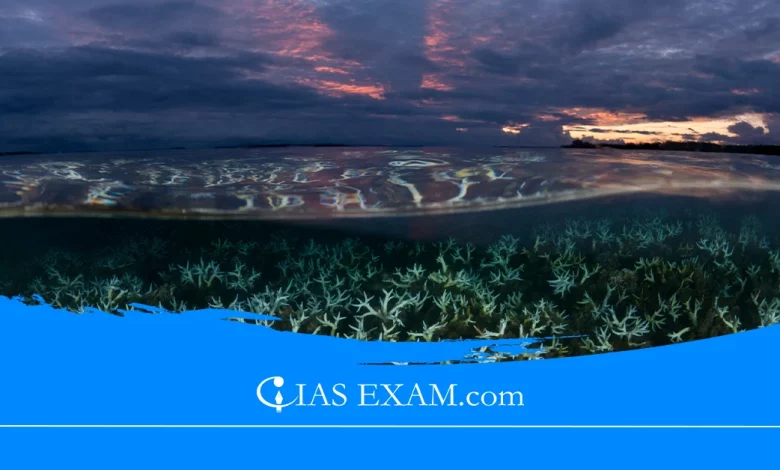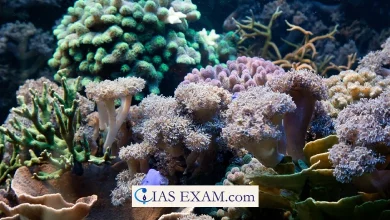Daily Current Affairs for UPSC
Rising Global Sea Surface Temperature
Syllabus - Environment [GS Paper-3]

Context
The average global sea surface temperature (SST) for February 2024 was 21.06 degree Celsius, the highest ever since 1979.
Reasons for Rising SST
- Human Activities: Since the Industrial Revolution kicked off in the nineteenth Century, human activities along with burning fossil fuels have produced excessive levels of greenhouse gases (GHGs) in the environment.
- Carbon dioxide, methane, ozone, and nitrous oxide are some of the major GHGs, which entice heat in the environment and contribute to global warming.
- As a result, the average global temperature has risen as a minimum 1.2 degree Celsius above pre-industrial times.
- Absorption by Oceans: Almost 90 percent of the high heat trapped by GHGs has been absorbed by the oceans, making them step by step hotter over the decades.
- El Niño: A weather pattern that refers to an abnormal warming of surface waters in the equatorial Pacific Ocean — has contributed to each ocean warming and rising global surface temperatures.
- Weaker Winds: There is also less dust blowing off the Sahara Desert currently due to weaker-than-average winds.
- Typically, the dirt forms a “giant umbrella that shades” the Atlantic water and decreases ocean temperatures.
- But now, the umbrella has partially folded and more of the Sun is beating down on the ocean.
Impact of Risisng SST
- Ocean Stratification: Warmer oceans cause an growth in ocean stratification — the natural separation of an ocean’s water into horizontal layers by density, with warmer, lighter, much less salty, and nutrient-negative water layering on top of heavier, less warm, saltier, nutrient-rich water.
- Usually, ocean ecosystems, currents, wind, and tides mix those layers.
- The upward push in temperatures, but, has made it more difficult for water layers to mix with each other.
- Due to this, oceans are capable of taking in less carbon dioxide from the environment and the oxygen absorbed isn’t able to mix well with cooler ocean waters under, threatening the survival of marine life.
- Threat to Phytoplanktons: Nutrients aren’t capable of traveling up to the surface of the oceans from below. This could threaten the population of phytoplankton — single-celled vegetation that thrive on the ocean floor and are the bottom of numerous marine food webs.
- Phytoplankton are eaten by zooplankton, which are fed on by other marine animals including crabs, fish, and sea stars.
- Therefore, if the phytoplankton population plummets, there will be a collapse of marine ecosystems.
- Marine Heat Waves: Warmer oceans cause marine heat waves (MHWs), which arise when the surface temperature of a selected vicinity of the ocean rises to 3 or 4 degree Celsius above the average temperature for at least 5 days.
- Between 1982 and 2016, such heat waves doubled in frequency and have become longer and more intense, according to the UN’s Intergovernmental Panel on Climate Change (IPCC).
- MHWs are devastating for marine ecosystems as they contribute to coral bleaching, and also affect the migration pattern of aquatic animals.
- Increase in Intensity of Cyclones: Warmer temperatures lead to a higher charge of evaporation as well as the switch of heat from the oceans to the air.
- That’s why, while storms tour across warm oceans, they collect more water vapour and heat.
- This causes more effective winds, heavier rainfall, and more flooding whilst storms attain the land — meaning heightened devastation for humans.
Conclusion
- In 2023, the concentration of GHG the highest ranges ever recorded in the ecosystem.
- The only way to avoid or blunt the aforementioned consequences is to reduce GHG emissions.
Source: The Indian Express
UPSC Mains Practice Question
Q.‘Climate change’ is a global problem. How India will be affected by climate change? How Himalayan and coastal states of India will be affected by climate change? (2017)





.png)



